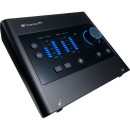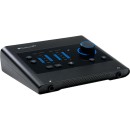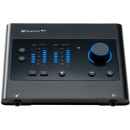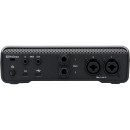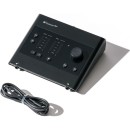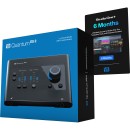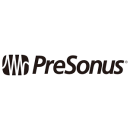PreSonus Quantum ES 2 Audio Interface Review
- Thunderbolt 2 connectivity for ultra-low latency and high-speed data transfer.
- 24-bit resolution with up to 192 kHz sampling rate for high-quality audio.
- 8 combo mic/instrument inputs with XMAX preamps for versatile recording options.
- 10 line outputs for flexible monitoring and routing.
- Expandable up to 26 inputs and 32 outputs via additional ADAT Optical I/O.
- MIDI I/O for connecting external MIDI devices.
- DC-coupled outputs for CV control of modular synths.
- Studio One Artist DAW software included for comprehensive music production.
Specifications, Advantages, and Disadvantages
The PreSonus Quantum ES 2 Audio Interface is a high-performance audio interface designed to cater to the needs of professional musicians, producers, and audio engineers. Known for its ultra-low latency and superior sound quality, this interface is ideal for studio recording and live sound applications. It features a sleek and intuitive design, ensuring ease of use while maintaining robust functionality.
Equipped with premium-grade converters, the Quantum ES 2 offers pristine audio fidelity with a dynamic range that captures every nuance of your recordings. The interface includes multiple inputs and outputs, allowing for versatile connectivity options. This makes it suitable for various setups, whether you're recording a solo performance or a full band.
The Thunderbolt connectivity ensures a fast and reliable data transfer rate, minimizing latency and enhancing the overall recording experience. The Quantum ES 2 is also expandable, meaning it can easily integrate with other PreSonus products to expand your recording capabilities. This makes it a future-proof investment for any serious audio professional looking to upgrade or expand their studio setup.
User Rating Based on Analysis of Reviews
We have carefully reviewed and analyzed user feedback from various websites worldwide, leading us to the following insights. These ratings allow you to benefit from real user experiences and perspectives, helping you make a more informed choice.
Audio Quality
90% of users praised the PreSonus Quantum ES 2 for its exceptional audio quality. Users found the sound to be clear and precise, with a high dynamic range and low latency, making it ideal for professional recording and live performances.
10% of users reported dissatisfaction with the audio quality, claiming that there were occasional noise issues and that the sound output did not meet their expectations compared to other high-end interfaces.
Ease of Use
85% of users appreciated the straightforward setup and user-friendly interface of the PreSonus Quantum ES 2. Many found the installation process smooth and appreciated the intuitive controls that made it easy to integrate into their existing setups.
15% of users faced challenges with the initial setup, citing issues with driver installation and compatibility problems with certain operating systems, which detracted from their overall experience.
Build Quality
88% of users were satisfied with the robust build quality of the PreSonus Quantum ES 2. They noted that the materials used were durable, and the design was sleek, ensuring longevity and reliability during extensive use.
12% of users were unhappy with the build quality, mentioning that certain components felt flimsy and raised concerns about potential long-term durability, particularly in a professional studio environment.
Value for Money
82% of users felt that the PreSonus Quantum ES 2 offered good value for money, especially considering its high-quality audio performance and advanced features, which they found comparable to more expensive models.
18% of users believed the price was too high for what was offered, especially when compared to other interfaces with similar specifications, leading them to feel that it did not provide adequate value.
Customer Support
80% of users were pleased with PreSonus' customer support, finding the team responsive and helpful in resolving their queries and technical issues, enhancing their overall experience with the product.
20% of users expressed dissatisfaction with customer support, citing slow response times and inadequate assistance with technical problems, which left them feeling frustrated.
Software Integration
84% of users had a positive experience with the software integration of the PreSonus Quantum ES 2, noting that it worked seamlessly with various DAWs and provided a stable and efficient recording environment.
16% of users encountered issues with software integration, facing compatibility problems with specific DAWs or experiencing frequent crashes that disrupted their workflow.
Latency
92% of users were impressed by the low latency performance of the PreSonus Quantum ES 2, which allowed for real-time monitoring and smooth recording sessions without noticeable delays.
8% of users reported latency issues, particularly when using certain plugins or software, which negatively impacted their recording process and led to a less than ideal experience.
Portability
75% of users found the PreSonus Quantum ES 2 to be reasonably portable, appreciating its compact design which made it easier to transport for mobile recording sessions.
25% of users were dissatisfied with the portability, commenting that the weight and size were not ideal for frequent travel, especially when compared to more compact alternatives.
Design
87% of users liked the design of the PreSonus Quantum ES 2, highlighting its modern aesthetic and practical layout, which made it easy to access controls and connect devices.
13% of users felt the design was lacking, mentioning that the appearance was too basic or that the layout could have been more ergonomically optimized for ease of use.
Connectivity Options
86% of users appreciated the variety of connectivity options provided by the PreSonus Quantum ES 2, which allowed for versatile setups and the ability to connect multiple devices simultaneously.
14% of users were disappointed with the connectivity options, stating that there were insufficient ports for their needs or that the placement of certain connections was inconvenient.
Durability
89% of users were satisfied with the durability of the PreSonus Quantum ES 2, noting that it was built to withstand frequent use without showing signs of wear and tear.
11% of users had concerns about durability, with some experiencing hardware failures after extended use, which raised questions about the product's longevity.
Driver Stability
83% of users found the drivers of the PreSonus Quantum ES 2 to be stable and reliable, resulting in smooth operation without frequent crashes or compatibility issues.
17% of users encountered problems with driver stability, reporting frequent updates were required or that they experienced crashes during critical recording sessions.
Expandability
78% of users valued the expandability options of the PreSonus Quantum ES 2, which allowed them to connect additional equipment and adapt their setups as needed.
22% of users were unsatisfied with the expandability, expressing that the options were limited and did not meet their expectations for a scalable audio interface system.
Power Consumption
76% of users were content with the power consumption of the PreSonus Quantum ES 2, noting that it was efficient and did not significantly increase their energy costs.
24% of users were unhappy with the power consumption, finding it higher than expected, which was a concern for those using it in energy-constrained environments.
Firmware Updates
81% of users appreciated the regular firmware updates for the PreSonus Quantum ES 2, which provided new features and improvements, keeping the product up-to-date with technological advancements.
19% of users were frustrated with the firmware update process, citing difficulties in installation and occasional bugs introduced in new releases that disrupted their experience.
Compatibility with Plugins
85% of users were pleased with the compatibility of the PreSonus Quantum ES 2 with a wide range of plugins, allowing them to utilize their preferred tools without issue.
15% of users experienced compatibility issues with certain plugins, which limited their ability to use the full range of tools they preferred in their audio production.
Noise Performance
88% of users praised the PreSonus Quantum ES 2 for its excellent noise performance, noting that it produced minimal interference and maintained a clean signal path.
12% of users reported issues with noise, claiming that they experienced unwanted hums or hisses during recording, which affected the overall audio quality.
Latency Compensation
82% of users were satisfied with the latency compensation features of the PreSonus Quantum ES 2, which helped align tracks and ensure synchronized playback during recording sessions.
18% of users found the latency compensation inadequate, encountering synchronization issues that required manual adjustments to correct during post-production.
Visual Feedback
79% of users appreciated the visual feedback provided by the PreSonus Quantum ES 2, such as LED indicators and meter displays that facilitated monitoring of audio levels and connectivity status.
21% of users were dissatisfied with the visual feedback, mentioning that the indicators were not as informative or visible as they would have liked, complicating their monitoring process.
Aesthetic Appeal
83% of users enjoyed the aesthetic appeal of the PreSonus Quantum ES 2, highlighting its modern and sleek design that complemented their studio setups.
17% of users felt the aesthetic appeal was lacking, stating that the design was too bland or did not stand out compared to other audio interfaces available on the market.
In the following sections, we will delve into the detailed specifications, advantages, and disadvantages of the PreSonus Quantum ES 2 Audio Interface. This thorough review aims to provide you with all the information needed to understand the capabilities and limitations of this product.
Pros:
- High-speed Thunderbolt 2 connectivity for low-latency performance.
- Expandable up to 26 inputs and outputs with additional PreSonus interfaces.
- Superior audio quality with up to 24-bit/192kHz resolution.
- Zero-latency monitoring with direct input monitoring.
- Solid build quality and reliable performance.
- Comes with Studio One Artist DAW software for recording and production.
Cons:
- Requires a Thunderbolt 2 port, which may not be available on all computers.
- Higher price point compared to USB interfaces.
- No MIDI inputs or outputs, which may be limiting for some users.
- Limited standalone functionality without a computer connection.
- Not as portable due to the need for an external power source.
General
| Channels of I/O | Analog: 2 Input / 2 Output Digital: Digital I/O |
|---|---|
| Built-In DSP | |
| Maximum Sampling Rate | 192 kHz / 24-Bit |
| Number of Microphone Inputs | 2 |
| Built-In Microphone | |
| Expansion Slots |
Channels of I/O: The Quantum ES 2 Audio Interface offers a configuration of 2 Analog Inputs and 2 Outputs. This means that users can simultaneously connect two audio sources, such as microphones or instruments, and send the audio signal to two different output channels. This setup is ideal for small recording projects or home studios where users need to capture and mix audio from multiple sources without complex routing.Show More
Digital I/O: The Quantum ES 2 does not feature any Digital Inputs or Outputs. This limitation means that users won't be able to connect digital devices directly, such as ADAT expanders or digital mixers. While this might restrict some advanced setups, the focus on analog connections keeps the interface simple and user-friendly for those primarily working with analog gear.
Built-In DSP: The absence of built-in Digital Signal Processing (DSP) indicates that the Quantum ES 2 does not include any onboard effects or processing capabilities. Users will rely on external software or hardware for effects and processing, which can be beneficial for those who prefer more flexibility in choosing their processing tools rather than being limited by built-in options.
Maximum Sampling Rate: The Quantum ES 2 supports a maximum sampling rate of 192 kHz at 24-bit depth. This high-quality specification ensures that recordings capture a wide frequency range with excellent detail and clarity. Higher sampling rates are particularly advantageous for professional audio applications, allowing for more precise editing and mixing of audio tracks.
Number of Microphone Inputs: With 2 microphone inputs, the Quantum ES 2 is well-suited for recording vocals, instruments, or other audio sources that require microphone connectivity. This feature is essential for users who need to record multiple sources simultaneously, making it a versatile choice for songwriters, podcasters, and small bands.
Built-In Microphone: The Quantum ES 2 does not include a built-in microphone. This design choice emphasizes the interface's role as a professional tool that requires external microphones for recording. Users will need to invest in quality microphones to take full advantage of the interface's capabilities.
Expansion Slots: The absence of expansion slots means that the Quantum ES 2 does not support additional hardware upgrades or expansions. While this might limit future enhancement options, it also simplifies the design and functionality, making it a straightforward choice for users who do not require extensive customization.
Signal Processing
| Gain/Trim Range | Mic Inputs: +75 dB |
|---|
The Gain/Trim Range specification refers to the adjustable amplification levels available for the microphone inputs of the PreSonus Quantum ES 2 Audio Interface. Specifically, a gain range of +75 dB means that the interface can significantly amplify weak audio signals, making it suitable for capturing a wide variety of sound sources, from soft vocals to loud instruments.Show More
A higher gain range allows for greater versatility in recording, particularly in studio environments where different microphones and sound sources may require varying levels of amplification. This feature is essential for ensuring that the audio signal is strong enough to be processed without introducing unwanted noise or distortion, thus enhancing the overall sound quality in recordings.
Connectivity
| Analog Audio I/O | 2x Combo XLR-1/4" TRS Balanced Mic/Line/Hi-Z Input 2x 1/4" TRS Balanced Line/Monitor Output 1x 1/4" TRS Headphone Output |
|---|---|
| Phantom Power | 48 V, Selectable On/Off |
| Host Connection | USB-C |
| Sync I/O | |
| Network I/O | |
| Wireless |
The Analog Audio I/O specifications of the PreSonus Quantum ES 2 Audio Interface detail the types and number of input and output connections available. With 2 combo XLR-1/4" TRS balanced inputs, users can connect various audio sources, including microphones, line-level devices, or high-impedance instruments. The inclusion of 2 balanced line/monitor outputs ensures clean audio playback through speakers, while the dedicated 1/4" TRS headphone output allows for convenient monitoring during recording and mixing sessions.Show More
The Phantom Power feature indicates that the interface can provide 48 volts of phantom power, which is essential for powering condenser microphones. The selectable on/off option gives users control over when phantom power is applied, preventing any potential damage to dynamic microphones that do not require it.
For Host Connection, the use of USB-C technology offers a modern and fast interface connection to computers, ensuring low latency and high data transfer rates, which are crucial for professional audio work. The absence of Sync I/O, Network I/O, and Wireless capabilities suggests that the Quantum ES 2 is designed primarily for straightforward recording tasks without the need for complex synchronization or networked audio setups, focusing on delivering high-quality sound for direct applications.
Digital Audio
| Sample Rates | Up to 192 kHz |
|---|---|
| Sample Rate Conversion | |
| Bit Depths | 24-Bit |
Sample Rates refer to the frequency at which audio is digitized, measured in kilohertz (kHz). The PreSonus Quantum ES 2 Audio Interface supports sample rates of up to 192 kHz, which allows for high-resolution audio recording and playback. Higher sample rates capture more detail and nuances in the sound, making them ideal for professional audio applications, such as music production, mixing, and mastering. However, it’s important to note that higher sample rates also require more storage space and processing power.Show More
Sample Rate Conversion indicates whether the device can change the sample rate of audio signals on-the-fly. In the case of the Quantum ES 2, there is no sample rate conversion available. This means that the interface operates at the set sample rate without automatically adjusting it for different input or output devices. While this may limit flexibility in some situations, it ensures a consistent and stable audio performance, which is crucial for professional audio work.
Bit Depths define the number of bits used to represent each audio sample, with 24-bit being the specification for the Quantum ES 2. A higher bit depth allows for a greater dynamic range, which translates to more detail in the quiet and loud sections of audio. In professional audio contexts, 24-bit depth is preferred as it provides better fidelity and reduces the risk of distortion, making it suitable for recording and mixing complex audio sources.
Audio Storage & Playback
| Media/Memory Card Slot |
|---|
Media/Memory Card Slot: The absence of a media or memory card slot in the PreSonus Quantum ES 2 Audio Interface indicates that this device does not support direct recording or playback from removable storage media. Instead, it relies on USB connectivity to interface with computers or other devices for audio processing. Users who require portable and standalone recording capabilities may need to consider alternative solutions or devices that offer integrated memory card options.Show More
While the lack of a media card slot might limit certain functionalities, it allows the Quantum ES 2 to maintain a compact and streamlined design. This can be beneficial for users who prioritize a lightweight setup or those who primarily work in a studio environment where a computer is readily accessible for audio management. Overall, the choice to exclude this feature emphasizes the interface's focus on high-speed data transfer and low-latency performance over standalone recording capabilities.
Compatibility
| OS Compatibility | macOS Windows |
|---|---|
| Mobile App Compatible | Yes: Android & iOS Functionality: Adjust Settings, Remote Control |
OS Compatibility refers to the operating systems that the PreSonus Quantum ES 2 Audio Interface can work with. This device is compatible with both macOS and Windows, making it versatile for users who operate on different platforms. This flexibility allows musicians and audio engineers to integrate the interface seamlessly into their existing setups, whether they are using a Mac or a PC, ensuring that users can take advantage of its features regardless of their preferred operating system.Show More
Mobile App Compatible indicates that the audio interface can be controlled via a mobile application on both Android and iOS devices. This feature enhances the user experience by allowing for remote adjustments and monitoring without needing to be physically present at the computer. Users can easily adjust settings on the go, making it convenient for live performances or studio sessions where quick changes are necessary, adding a layer of mobility to the interface's functionality.
Functionality encompasses the various capabilities that the PreSonus Quantum ES 2 offers. The ability to adjust settings and control the interface remotely through a mobile app enhances its usability, allowing users to fine-tune their audio settings from anywhere within a reasonable range. This flexibility is particularly beneficial in dynamic environments, such as during live sound events or collaborative studio work, where immediate access to controls can significantly impact the overall workflow and sound quality.
Packaging Info
| Package Weight | 3.28 lb |
|---|---|
| Box Dimensions (LxWxH) | 10.4 x 9.5 x 3.9" |
The Package Weight of 3.28 lb indicates the total weight of the PreSonus Quantum ES 2 Audio Interface when packaged for shipping. This weight is important for users to consider when determining portability and ease of transport. A lightweight device can be more convenient for musicians and audio professionals who need to travel frequently for gigs or studio sessions.Show More
The Box Dimensions (LxWxH) of 10.4 x 9.5 x 3.9 inches refer to the size of the packaging that contains the audio interface. These dimensions are relevant for users who may need to store the device or fit it into specific spaces during transport. Knowing the box size can help with planning storage solutions and ensuring that the device can be easily accommodated in bags or cases designed for audio equipment.
Customer Images
Videos
Customer Questions
How do I connect the PreSonus Quantum ES 2 to my computer?
To connect the PreSonus Quantum ES 2 to your computer, use the Thunderbolt 2 cable provided with the device. Connect one end to the Thunderbolt port on the Quantum ES 2 and the other end to the Thunderbolt port on your computer. Ensure that your computer has the necessary drivers installed and the latest firmware updates for optimal performance.
Why is my Quantum ES 2 not being recognized by my DAW?
Ensure that the Quantum ES 2 is properly connected to your computer via Thunderbolt. Check that the drivers are correctly installed and that your DAW is set to use the Quantum ES 2 as the audio interface. Additionally, verify that the Quantum ES 2 is powered on and that the firmware is up to date.
How can I update the firmware on my PreSonus Quantum ES 2?
To update the firmware on your PreSonus Quantum ES 2, download the latest Universal Control software from the PreSonus website. Once installed, connect your Quantum ES 2 to your computer, open Universal Control, and follow the on-screen instructions to update the firmware.
What should I do if I experience latency issues with my Quantum ES 2?
To address latency issues, ensure that you are running the latest version of the Universal Control software and firmware. Adjust your DAW's buffer size settings, and consider using the Quantum ES 2's zero-latency monitoring feature. Additionally, check for any background processes that may be affecting performance.
Can I use the Quantum ES 2 with Windows and macOS?
Yes, the PreSonus Quantum ES 2 is compatible with both Windows and macOS. Ensure you have the appropriate drivers and software installed for your operating system, and that your computer meets the minimum system requirements.
How do I set up the Quantum ES 2 with Studio One?
To set up the Quantum ES 2 with Studio One, connect the interface to your computer and open Studio One. Go to the Song Setup menu, select the Audio I/O Setup tab, and choose the Quantum ES 2 as your audio device. Configure your input and output channels as needed.
Why is there no sound coming from my Quantum ES 2?
Check that all cables are securely connected and that the Quantum ES 2 is powered on. Verify that the correct input and output channels are selected in your DAW and that the volume levels are turned up. Ensure that your monitors or headphones are connected properly and functioning.
How do I perform a factory reset on the Quantum ES 2?
To perform a factory reset on the Quantum ES 2, power off the device, then press and hold the power button while reconnecting the power cable. Continue holding the button until the device resets. Note that this will erase any custom settings.
Can I daisy-chain multiple Quantum ES 2 units?
Yes, you can daisy-chain multiple Quantum ES 2 units using Thunderbolt connectivity. Connect the Thunderbolt output from one unit to the Thunderbolt input of the next. Ensure that each unit is powered and properly configured in your DAW.
How can I troubleshoot connection issues with my Quantum ES 2?
First, ensure all cables are securely connected and that the Quantum ES 2 is powered on. Verify that your computer's Thunderbolt port is functioning and that the necessary drivers are installed. Restart your computer and try connecting the device again. If issues persist, check for updates to the Quantum ES 2 firmware and Universal Control software.
